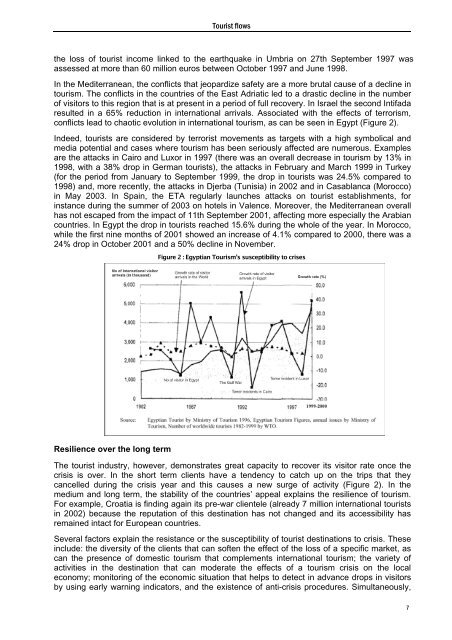dossier sur le tourisme et le développement durable
dossier sur le tourisme et le développement durable
dossier sur le tourisme et le développement durable
Create successful ePaper yourself
Turn your PDF publications into a flip-book with our unique Google optimized e-Paper software.
Tourist flows<br />
the loss of tourist income linked to the earthquake in Umbria on 27th September 1997 was<br />
assessed at more than 60 million euros b<strong>et</strong>ween October 1997 and June 1998.<br />
In the Mediterranean, the conflicts that jeopardize saf<strong>et</strong>y are a more brutal cause of a decline in<br />
tourism. The conflicts in the countries of the East Adriatic <strong>le</strong>d to a drastic decline in the number<br />
of visitors to this region that is at present in a period of full recovery. In Israel the second Intifada<br />
resulted in a 65% reduction in international arrivals. Associated with the effects of terrorism,<br />
conflicts <strong>le</strong>ad to chaotic evolution in international tourism, as can be seen in Egypt (Figure 2).<br />
Indeed, tourists are considered by terrorist movements as targ<strong>et</strong>s with a high symbolical and<br />
media potential and cases where tourism has been seriously affected are numerous. Examp<strong>le</strong>s<br />
are the attacks in Cairo and Luxor in 1997 (there was an overall decrease in tourism by 13% in<br />
1998, with a 38% drop in German tourists), the attacks in February and March 1999 in Turkey<br />
(for the period from January to September 1999, the drop in tourists was 24.5% compared to<br />
1998) and, more recently, the attacks in Djerba (Tunisia) in 2002 and in Casablanca (Morocco)<br />
in May 2003. In Spain, the ETA regularly launches attacks on tourist establishments, for<br />
instance during the summer of 2003 on hotels in Va<strong>le</strong>nce. Moreover, the Mediterranean overall<br />
has not escaped from the impact of 11th September 2001, affecting more especially the Arabian<br />
countries. In Egypt the drop in tourists reached 15.6% during the who<strong>le</strong> of the year. In Morocco,<br />
whi<strong>le</strong> the first nine months of 2001 showed an increase of 4.1% compared to 2000, there was a<br />
24% drop in October 2001 and a 50% decline in November.<br />
Resilience over the long term<br />
Figure 2 : Egyptian Tourism’s susceptibility to crises<br />
The tourist industry, however, demonstrates great capacity to recover its visitor rate once the<br />
crisis is over. In the short term clients have a tendency to catch up on the trips that they<br />
cancel<strong>le</strong>d during the crisis year and this causes a new <strong>sur</strong>ge of activity (Figure 2). In the<br />
medium and long term, the stability of the countries’ appeal explains the resilience of tourism.<br />
For examp<strong>le</strong>, Croatia is finding again its pre-war cliente<strong>le</strong> (already 7 million international tourists<br />
in 2002) because the reputation of this destination has not changed and its accessibility has<br />
remained intact for European countries.<br />
Several factors explain the resistance or the susceptibility of tourist destinations to crisis. These<br />
include: the diversity of the clients that can soften the effect of the loss of a specific mark<strong>et</strong>, as<br />
can the presence of domestic tourism that comp<strong>le</strong>ments international tourism; the vari<strong>et</strong>y of<br />
activities in the destination that can moderate the effects of a tourism crisis on the local<br />
economy; monitoring of the economic situation that helps to d<strong>et</strong>ect in advance drops in visitors<br />
by using early warning indicators, and the existence of anti-crisis procedures. Simultaneously,<br />
7
















